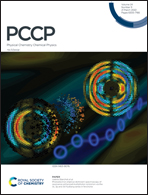Crystallography-based exploration of non-covalent interactions for the design and synthesis of coumarin for stronger protein binding†
Abstract
Protein molecules are a good target for the inhibition or promotion of biological processes. Different methods like QSAR and molecular docking have been developed to accurately design small binder molecules for target proteins. An alternative model has been developed wherein a statistical method is used to find the propensity of different non-covalent interactions between small molecules and amino acid residues of the protein. The results give hints as to the choice of substituents required at the SM to strongly bind to a protein. In this case, 75 different types of proteins bound with coumarin derivatives have been investigated and the non-covalent interactions observed between the basic coumarin moiety and amino acids have been analyzed. Density functional theory (DFT) calculations were used to identify the electronic features of coumarin to understand the feasibility of the observed non-covalent interactions and to find appropriate groups that can modulate these interactions. The binding affinity towards a protein (β-lactoglobulin (BLG)) and the stability of the protein complex have been investigated through docking and molecular dynamics of 100 ns, respectively. The modeled compounds were synthesized and investigated with regards to their interactions with the model carrier protein. The thermodynamics of the interactions were also investigated and the binding is governed by the Le Chatelier principle.



 Please wait while we load your content...
Please wait while we load your content...